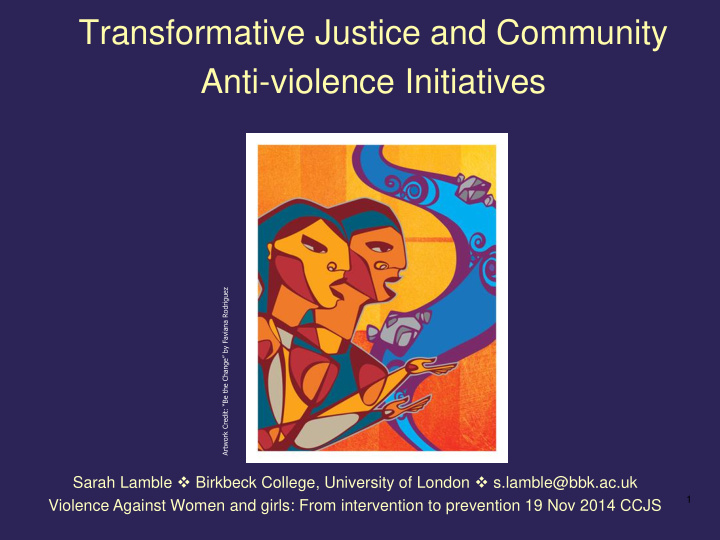



Transformative Justice and Community Anti-violence Initiatives Artwork Credit: “Be the Change” by Faviana Rodriguez Sarah Lamble Birkbeck College, University of London s.lamble@bbk.ac.uk 1 Violence Against Women and girls: From intervention to prevention 19 Nov 2014 CCJS
Generation Five: Transformative Justice Goals of Transformative Justice: • Safety, healing, and agency for survivors • Accountability & transformation for people who harm • Community action, healing, and accountability • Transformation of the social conditions that perpetuate violence - systems of oppression and exploitation, domination, and state violence Principles of Transformative Justice: • Liberation • Shifting power • Accountability • Safety • Collective Action • Respect Cultural Difference / Guard against Cultural Relativism • Sustainability 2 www.generationfive.org
Community-base anti-violence initiatives • Generation Five • INCITE! Women of Color Against Violence • Critical Resistance • Creative Interventions /StoryTelling & Organising Project • Chrysalis Collective • Far Out Project • Communities United Against Violence • Communities Against Rape and Violence (CARA) • Love Sex, Hate Sexism • Philly’s Pissed / Philly Stands Up 4
Lovesexhatesexism.com
http://farout.org/
www.creative-interventions.org
A different approach A. Keeping a community focus on survivor support – “How can we use our connection and care for people who are victims or survivors of violence to not only provide safety but also opportunities for them to heal and re- connect to healthier relationships?” B. Refusing to resort to, or rely on, threats of punishment, isolation or exclusion – “How can we change violent behaviour by using our connection and care for people who have caused harm rather than using threats, punishment or policing? (’ (Creative Interventions 2012, [Section 2] 4) A. Building community capacity / fostering skills for everyday intervention and prevention of violence – Creative Interventions aims to “Make violence intervention an everyday skills— rather than something that waits and waits until it’s too late. B. Developing a more holistic analysis
How it works: Community intervention steps 1. Getting Clear: What is going on? 2. Staying Safe: How do we stay safe? 3. Mapping Allies and Barriers: Who can help? 4. Setting Goals: What do we want? 5. Supporting Survivors or Victims: How can we help? 6. Taking Accountability: How can we change violence? 7. Working together: How do we work together as a team? 8. Keeping on Track: How do we move forward? Artwork credit: “ Communitree ” , Anonymous, HMP Cookham Wood, Koestler Trust 2011 12
Recommend
More recommend